
views
Names for Groups of Mammals & Marsupials

Some mammals are known to form complex groups with social hierarchies. Not all mammals enjoy company in the wild, but many species live in groups for protection. Some even hunt and attack enemies together, showing complex social cooperation (remember those orca pods attacking yachts?). Here’s what you can call a group of mammals: Apes: a shrewdness Badgers: a cete or colony Bats: a cauldron Bears: a sloth or sleuth Buffalo: a gang or obstinacy Cats: a clowder, pounce, or glaring Cheetahs: a coalition Deer: a brace (two) or leash (three) Dogs: a pack (wild) or cowardice (curs) Dolphins: a herd, school, or pod Donkeys: a pace or herd Echidnas: a parade Elephants: a parade Elk: a gang Ferrets: a business Fox: a leash, skulk, or earth Fur seals: a harem (belonging to one male) Giraffes: a tower or herd Goats: a tribe or trip Gorillas: a band Hares: a down, husk, or leash Hedgehogs: an array Hippopotamuses: a bloat or thunder Horses: a harras, span (team of two), or string Hyenas: a cackle Jaguars: a shadow Kangaroos: a troop or mob Kittens: a kindle, litter, or intrigue Lemurs: a conspiracy Leopards: a leap Lions: a pride Martens: a richness Mice: a mischief or nest Moles: a labor Monkeys: a troop or barrel Mules: a pack, span, or barren Otters: a romp Pigs: a drift, drove, sounder, team, or passel Platypus: a paddle Porcupines: a prickle Porpoises: a pod, school, herd, or turmoil Prairie dogs: a coterie Puppies: a litter Rabbits: a colony, berry, warren, nest, down, husk, or herd (domestic only) Rhinoceroses: a crash Roes: a bevy Rooks: a building or parliament Seals: a plump, spring, colony, or harem Sheep: a flock, fold, mob, or wing Squirrels: a dray (nest) or scurry Tigers: an ambush or streak Whales: a pod, gam, or herd Wild cats: a destruction Wolves: a pack, rout, or route (when in movement) Wombats: a wisdom Zebras: a zeal or dazzle
Names for Groups of Birds
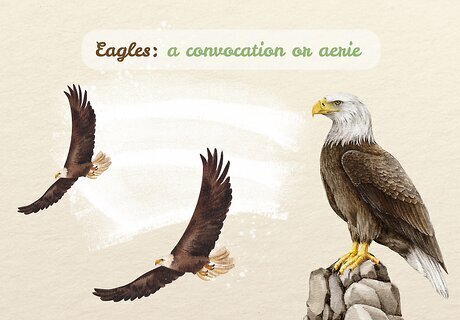
Many bird species flock together for all or part of the year. Many birds flock together year-round for protection and to find food, while some only gather for mating season or to migrate. Different species of birds have even been sighted flocking together to form extra huge groups! If you spot a group of birds flying overhead, here’s what you can call them: Bitterns: a sedge Buzzards: a wake Bobolinks: a chain Choughs: a clattering Coots: a cover Cormorants: a gulp Crows: a murder or horde Dotterel: a trip Doves: a dule or pitying (specific to turtle doves) Ducks: a brace, team, flock (in flight), raft (on water), paddling, or badling Dunlins: a fling (in flight) Eagles: a convocation or aerie Emus: a mob Falcons: a cast (a pair released after game) Finches: a charm or chirm Flamingos: a stand or flamboyance Fowl: a plump, trip, or skein (in flight) Geese: a flock, gaggle (on the ground), or skein (in flight) Goldfinches: a charm Grouse: a pack (in late season) Hawks: a cast, kettle (in flight), or boil (two or more spiraling in the air) Herons: a sedge or siege Jays: a party or scold Lapwings: a deceit Larks: an exaltation Magpies: a tiding, gulp, murder, or charm Mallards: a sord (on the ground) or brace Nightingales: a watch Owls: a parliament Parrots: a pandemonium or company Partridge: a covey Peafowl or peacocks: an ostentation or muster Penguins: a colony, muster, parcel, or rookery Pheasant: a nest, nide (a brood), nye, or bouquet Pigeons: a kit Plovers: a congregation or wing (in flight) Ptarmigans: a covey Quail: a bevy or covey Ravens: an unkindness Rooks: a building Ruffs: a hill Sheldrakes: a dropping Snipes: a walk or wisp Sparrows: a host Starlings: a murmuration Storks: a mustering Swans: a bevy, game, or wedge (in flight) Teal: a spring Turkeys: a rafter or gang Waterfowl: a bunch, knob (less than 30), or raft (on water) Woodcocks: a fall Woodpeckers: a descent
Names for Groups of Reptiles & Amphibians
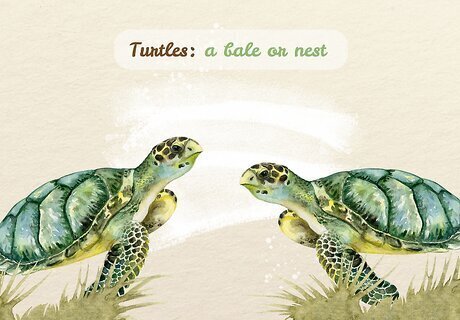
Most reptiles prefer solitude, but some naturally form groups or families. You’ll most likely see groups of reptiles at pet stores, but this isn’t necessarily their preferred living situation—caging too many together can make them feel stressed, crowded, or territorial. However, some reptiles and amphibians (like many turtle species and geckos) fare well in large groups. Here are the words you can use in case you discover a rare group of reptiles together: Alligators: a congregation Axolotls: a harem Cobras: a quiver Crocodiles: a bask Frogs: an army Geckos: a clutter Iguanas: a mess or slaughter Toads: a knot Turtles: a bale or nest Salamanders: a maelstrom Snakes and vipers: a nest
Names for Groups of Fish & Sea Creatures
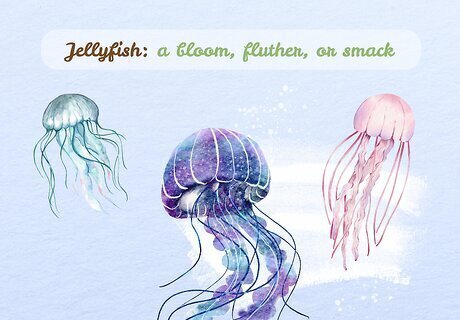
Many marine animals like fish live in groups, but others are more solitary. Sea creatures include fish, mollusks and shellfish, crustaceans, and more—even some mammals, reptiles, and amphibians! While some species, like fish, live most of their lives together, others (like squids) only come together for hunting or mating purposes. Here are the most common group names for sea creatures: Clams: a bed Crabs: a consortium Fish (general): a draft, nest, run, school, or shoal Herring: an army Jellyfish: a bloom, fluther, or smack Lobsters: a risk Manta rays: a squadron Oysters: a bed Seahorses: a herd Sharks: a shiver Squid: an audience Starfish: a galaxy Stingrays: a fever Trout: a hover
Names for Groups of Insects
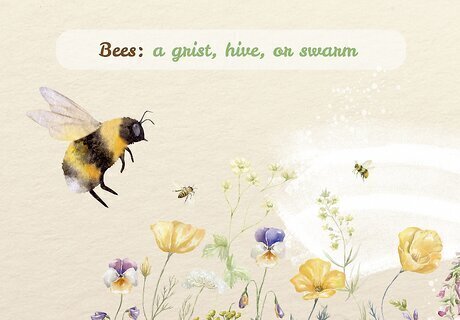
Most insects don’t form groups unless they need to mate or travel. There are some obvious exceptions, like ants that live in colonies or bees that build and guard nests, but many other species (think flies, butterflies, or mosquitoes) live on their own most of the time. However, you don’t have to just call the gathering a swarm—here are more creative names for giant groups of bugs and insects: Ants: a colony or army Bees: a grist, hive, or swarm Butterflies: a kaleidoscope or flutter Caterpillars: an army Cockroaches: an intrusion Dragonflies: a flight or cluster Flies: a business Gnats: a cloud or horde Grasshoppers: a cloud Hornets: a nest or bike Ladybugs: a loveliness Locusts: a plague Mosquitoes: a scourge Moths: an eclipse Scorpions: a nest or bed Slugs: a herd or cornucopia Snails: a hood Spiders: a cluster or clutter Termites: a brood
Spotlight on Unique Animal Group Names
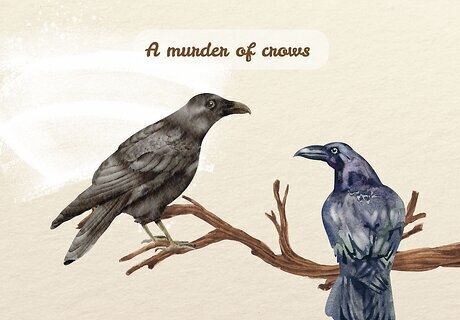
A murder of crows Contrary to their group name, crows aren’t murderous (although new research shows they can hold a grudge and remember a face!). The term “murder” most likely comes from superstition. It was believed that a group of crows would gather to decide the fate of other crows, or to circle around sites where animals or humans were expected to die soon. Because they’re scavengers, crows are also associated with graveyards, battlefields, and dead bodies.

A pride of lions There are multiple theories about where the term “pride” comes from. Some think it’s because of lions’ association with royalty, while some suggest it may be linked to the Latin word praeda (meaning “prey,” referring to how lions hunt together). Whatever the reason, “pride” is actually a pretty old term for a group of lions that didn’t gain popularity until the early 1900s.
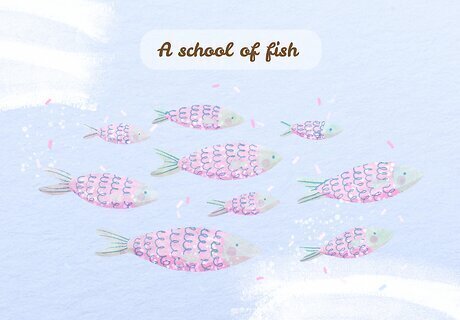
A school of fish A “school” of fish doesn’t actually refer to the academic building (that’s not to say fish aren’t smart, though!). The term actually comes from the Middle Dutch word schole or the Old English scolu, meaning “multitude” or “group of fish.” The term “shoal” (which can refer to either a group of fish or shallow water) also comes from the same roots. The root of “school” (as in the place you go to learn math) comes from the Greek word scholē, meaning “leisure.”
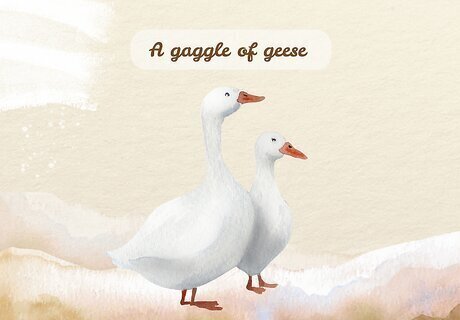
A gaggle of geese “Gaggle” probably comes from the Middle English gagel (meaning “cackling” or “chattering”). A group of geese is called a gaggle on the ground because they’re disorganized, loud, and rowdy—very different from their orderly formations when they’re flying!

A kaleidoscope of butterflies Some animal group names don’t come from ancient root words or superstitions, but from how humans actually see and interact with these creatures. For example, a group of butterflies is called a kaleidoscope because of all the fluttering colors, patterns, and movement you see when they’re flying together. “Kaleidoscope” is unique among animal group names—it’s the only one on our list named after a human invention.
Where do animal group names come from?
Many animal group names in English come from The Book of Saint Albans. The book, possibly translated from French into English in 1486, was written by Juliana Berners. The book includes many “terms of venery” (a fancy way to say a term for a collection or group of animals). These words are colorful, descriptive, and primarily used to describe groups of animals that were hunted for sport, food, or fur in the Middle Ages. Berners had a deep knowledge of wildlife, and some of the terms may be based on her own observations and meant to be playful (rather than academic). “Venery” comes from the Latin words venor (to hunt) and veneria (referring to goddess Venus or lust). Both meanings allude to “the chase” and became applied to hunted animals in the 1400s. Berners is credited as being one of (if not the) first woman to write about the English language. You’ve probably noticed there are way more names for groups of mammals and birds. That’s because people in the Middle Ages hunted those animals the most.
Frequently Asked Questions: Animal Group Names
Are these animal group names official? No—many of them are descriptive and fun, but are not considered official or scientific terms. As much as you might wish you had to say “a dazzle of zebras” to be considered correct, using more generic terms like “herd,” “flock,” or “swarm” is just as acceptable (and probably easier to understand for most people).
Why do animals gather in groups? Animals might gather in groups for a variety of reasons. Prey animals often find safety in numbers and can protect themselves from predators better together than individually. Some animals may primarily live solo, but come together in groups to feed, mate, or migrate together. And, just like humans, some animals simply need companionship to thrive!
What is a collective noun? A collective noun is a word that refers to a group of people or things. For example, words like “team” or “flock” are collective nouns. They’re interesting because the speaker is choosing to use a whole new word to describe a group instead of just making the members of the group plural (for example, saying “the team” instead of “the humans”).




















Comments
0 comment